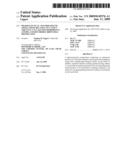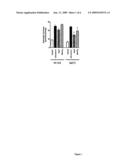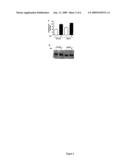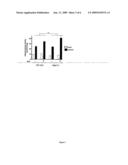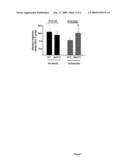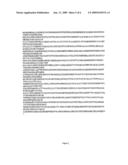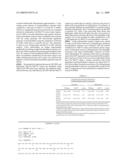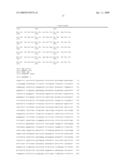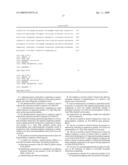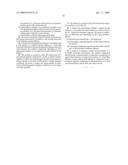Patent application title: Pharmaceutical and Therapeutic Applications Relating to a Type 9 Adenylyl Cyclase Polymorphism in Asthma and Reversible Bronchial Obstruction
Inventors:
Stephen B. Liggett (Clarksville, MD, US)
Stephen B. Liggett (Clarksville, MD, US)
IPC8 Class: AA61K317088FI
USPC Class:
514 12
Class name: Designated organic active ingredient containing (doai) peptide containing (e.g., protein, peptones, fibrinogen, etc.) doai 25 or more peptide repeating units in known peptide chain structure
Publication date: 2009-06-11
Patent application number: 20090149376
Claims:
1. A pharmaceutical composition comprising an expression product of a Type
Nine adenylyl cyclase gene polymorphism and a physiologically acceptable
carrier.
2. The pharmaceutical composition as recited in claim 1 wherein the expression product comprises AC9-Met722.
3. A pharmaceutical composition comprising an agent which increases an expression product of a Type Nine adenylyl cyclase gene polymorphism.
4. The pharmaceutical composition as recited in claim 3 wherein the expression product comprises AC9-Met722.
5. A method of treating a patient having asthma or a reversible bronchial obstruction, the method comprising administering a pharmaceutical composition comprising an expression product of a Type Nine adenylyl cyclase gene polymorphism and a physiologically acceptable carrier in conjunction with a treatment regimen comprising co-administration of at least one bronchodilator and at least one corticosteroid.
6. The method as recited in claim 4 wherein the at least one bronchodilator comprises a Beta2 agonist.
7. A method for treating a patient having asthma or a reversible bronchial obstruction, the method comprising(a) detecting a presence of the AC9-Met722 allelic variant in the patient;(b) identifying a patient who is a candidate for an effective treatment based on the presence of the AC9-Met722 allelic variant; and(c) administering the effective treatment.
8. The method as recited in claim 7 wherein the effective treatment comprises co-administration of a selective 2AR agonist and a corticosteroid.
9. A kit for determination of whether an individual will be responsive to a treatment with a pharmaceutical agent, the kit comprising: at least one reagent specifically capable of detecting a presence of at least one polymorphism within a Type Nine adenylyl cyclase gene;and instructions for determining whether the individual will be responsive.
10. The kit as recited in claim 9 wherein the at least one polymorphism comprises an AC9-Met722 gene polymorphism.
11. The kit as recited in claim 9 wherein the presence is detected by detecting an expression product of at least one polymorphism of a Type Nine adenylyl cyclase gene.
12. The kit as recited in claim 9 wherein the at least one reagent comprises a probe or primer which is capable of selectively hybridizing to a AC9 gene polymorphism segment as set forth in SEQ ID NO: 3 under stringent conditions, the probe or primer not being capable of selectively hybridizing under stringent conditions to a AC9 gene wild type segment as set forth in SEQ ID NO: 4.
13. An assay for screening pharmaceutical agents for efficacy in the treatment of asthma or reversible bronchial obstruction comprising:(a) measuring an amount of an expression product of an AC9 gene polymorphism and/or an amount of an expression product of a 2AR gene in the presence of a pharmaceutical agent with a corticosteroid;(b) measuring an amount of an expression product of an AC9 gene polymorphism and/or an amount of an expression product of a 2AR gene in the presence of a pharmaceutical agent without a corticosteroid;(c) identifying an effective pharmaceutical agent.
14. The assay as recited in claim 13 wherein an increase in the amount measured in (a) relative to the amount measured in (b) indicates greater efficacy.
15. A method for predicting the response to treatment with a 2AR agonist in a patient having asthma or a reversible bronchial obstruction wherein the patient is taking at least one corticosteroid, the method comprising: detecting an AC9 gene polymorphism or an expression product thereof in the patient.
16. The method as recited in claim 15 wherein the AC9 gene polymorphism is detected by a probe or primer which is capable of selectively hybridizing to the AC9 gene polymorphism segment as set forth in SEQ ID NO: 2 under stringent conditions, the probe or primer not being capable of selectively hybridizing under stringent conditions to an AC9 gene wild type segment.
17. The method as recited in claim 15 wherein the expression product is AC9-Met722.
18. A method for determining whether a patient having asthma or a reversible bronchial obstruction will be responsive to a particular treatment regimen, the method comprising: (a) detecting and identifying an AC9 gene polymorphism;(b) detecting and identifying a 2AR haplotype;(c) determining a pharmacogenetic profile index based on (a) and (b);(d) correlating the pharmacogenetic profile index with efficacy of the particular treatment regimen.
19. A method of treating a patient having asthma or a reversible bronchial obstruction, the method comprising administering a pharmaceutical composition comprising an agent which increases an expression product of a Type Nine adenylyl cyclase gene polymorphism in conjunction with a treatment regimen comprising co-administration of at least one bronchodilator and at least one corticosteroid.
Description:
RELATED APPLICATION
[0001]The present application claims priority to U.S. provisional patent application Ser. No. 60/673,924, filed on Apr. 22, 2005.
TECHNICAL FIELD
[0002]The present invention relates to pharmaceutical compositions and methods for treating asthma and other reversible bronchial obstructions. Specifically, the invention provides novel pharmaceutical compositions, pharmaceutical agent screening assays, and predicative and therapeutic methods based on the surprising discovery of an interaction between the presence of a type 9 adenylyl cyclase polymorphism and the efficacy of certain bronchodilators in conjunction with corticosteroid co-administration in affected patients.
BACKGROUND
[0003]Asthma is a chronic inflammatory disease of the airways characterized by contraction of airway smooth muscle due to actions of multiple local bronchoconstrictive substances. The syndrome affects ˜300 million individuals worldwide and is a substantial international health care burden. The inflammatory component of asthma is typically treated with corticosteroids, while the bronchoconstriction is treated with β-agonist bronchodilators, which as a class are the most prescribed therapeutic regimen for asthma treatment worldwide. Hence, the most commonly employed pharmacological treatment regimen indicated for asthma is co-administration of a bronchodilator and a corticosteroid. Significantly, however, corticosteroids are usually not indicated for intermittent asthma.
[0004]Problematically, the clinical response to β-agonists in the treatment of asthma displays a high degree of inter-individual variation that is not readily reconciled by clinical characteristics or baseline lung function. A significant fraction of patients appear to obtain no objective or subjective improvement with β-agonists, particularly when administered on a regularly scheduled regimen. Indeed, a recent analysis has estimated that ˜60% of the population variance in the forced expiratory volume in one second (FEV1) response to albuterol (a relatively selective Beta2-adrenergic bronchodilator and the active ingredient in PROVENTIL HFA) can be attributed to genetic variation. See Drazen, J. M., Silverman, E. K. and Lee, T. H. (2000) "Heterogeneity of therapeutic responses in asthma," Br. Med. Bull., 56, 1054-1070.
[0005]Therefore, further delineating the genetic basis of β-agonist responsiveness based on the role of other key genes in the early portion of the signal transduction pathway provides a potential basis for understanding the inter-individual variation, and provides additional targets for pharmacological intervention. In view of the marked heterogeneity in response to the most common treatment regimen for asthma, and given that some forms of asthma, and certain other reversible bronchial obstruction disorders which operate at least partly through the same mechanisms, can be symptomatically acute and life-threatening, there is an urgent need in the art for rapid methods of determining whether a given patient will be responsive to certain treatment regimens. In addition there is a need for methods of screening populations of asthmatic and other reversible bronchial obstruction patients in order to identify individuals who will not benefit from treatment regimens that expose the patient to a risk of serious side effects. Further, there is a need to develop treatment regimens which account for the clinically observed inter-individual variation in β2AR agonist response and a need for the development of screening assays for pharmaceutical agents with bronchodilation efficacy in the population of asthma and/or reversible bronchial obstruction patients which do not respond optimally to conventional treatment.
SUMMARY OF THE INVENTION
[0006]Accordingly, the present inventor focused on the effector component protein in the β2AR signaling pathway, adenylyl cyclase. In particular, the in vitro and in vivo phenotypes of a nonsynonymous polymorphism of adenylyl cyclase type 9 (AC9) were examined. This polymorphism was previously identified and comprises one nonsynonymous single nucleotide polymorphism (SNP), which results in a substitution of Ile for Met at amino acid 772. In contraindication to results of previous studies which suggest the opposite, the present inventor surprisingly discovered that presence of the Met772 polymorphism of AC9 imparts enhanced β2AR signal transduction in a corticosteroid-specific manner, and, in human asthma, the polymorphism is associated with enhanced β-agonist bronchodilator response under circumstances when corticosteroids are co-administered.
[0007]Hence, the present invention provides embodiments directed to pharmaceutical compositions, methods of treating patients having asthma or a reversible bronchial obstruction, methods for identifying a patient who is a candidate for an effective treatment based on the presence of the AC9-Met722 allelic variant, kits for rapid clinical determination of whether an individual will be responsive to a treatment with a pharmaceutical agent, assays for screening pharmaceutical agents for efficacy in the treatment of asthma or reversible bronchial obstruction, methods for predicting the response to treatment with a β2AR agonist in a patient having asthma or a reversible bronchial obstruction wherein the patient is taking at least one corticosteroid, and methods for determining whether a patient having asthma or a reversible bronchial obstruction will be responsive to a particular treatment regimen.
BRIEF DESCRIPTION OF THE FIGURES
[0008]FIG. 1. Characteristics of WT and Met772 AC9 in transfected A431 cells. Shown are the results from adenylyl cyclase studies performed in membranes from cells expressing the same levels of transfected WT and Met772 AC9. MnCl2 and NaF stimulated activities were lower in Met772 cells compared to WT. Results are from 5 experiments. *, P<0.05 compared to WT.
[0009]FIG. 2. Effects of corticosteroid treatment of transfected A431 cells on β2AR and AC9 expression. In A), results from 125I-CYP radioligand studies show that cells expressing WT and Met772 AC9 both displayed an equivalent increase in β2AR expression after 12 hours of exposure to dexamethasone (dex). Results are from 5 experiments. * P<0.01 compared to absence of dexamethasone. In B), a representative Western blot of AC9 shows that dexamethasone treatment did not increase expression of either AC9 allelic variants in these cells.
[0010]FIG. 3. Effects of corticosteroid treatment of transfected A431 cells on albuterol-stimulated adenylyl cyclase activities. The increase in albuterol-stimulated activities from dexamethasone (dex) treatment was greater for Met772 expressing cells vs WT, compared as either the absolute activities (P=0.02) or the fold increase over basal (P=0.006). *, significant as defined above.
[0011]FIG. 4. Interaction between corticosteroid treatment, AC9 genotype, and β-agonist bronchodilation in asthmatics. Results are from the clinical cohort as described in Methods, showing the average bronchodilator response over the 4 year follow-up period. Met772 patients experienced an improvement in bronchodilator response only if they were being treated with budesonide (P=0.006). The interaction P value for genotype and budesonide treatment is 0.002.
[0012]FIG. 5. Amino acid sequence comprising AC9-Met722 polymorphism
[0013]FIG. 6. DNA sequence comprising AC9-Met722 gene polymorphism
DETAILED DESCRIPTION
[0014]The following abbreviations are used throughout the present disclosure: AC9, adenylyl cyclase type 9; β2AR, β2-adrenergic receptor; 7-TM, seven transmembrane; Gs stimulatory guanine nucleotide binding protein; FEV1, forced expiratory volume in 1 sec; FVC, forced vital capacity; 125I-CYP, 125I-cyanopindolol; WT, wild-type (Ile772) allele.
[0015]The subject matter of all references cited in this disclosure is hereby incorporated fully into the disclosure by this reference.
[0016]As used herein, the term "reversible bronchial obstruction" refers to a bronchial obstruction which is reversible at least partly by a bronchodilator, and includes asthma and its various clinical subsets (such as exercise induced asthma, nocturnal asthma, non-allergic asthma), chronic obstructive pulmonary disease, emphysema, chronic bronchitis, and cystic fibrosis, and any other lung disease where constricted bronchi can be dilated by agents such as β-agonists. A person of ordinary skill in the art will recognize that there are some patients which fail a one-time β-agonist reversibility test but nevertheless respond clinically to β-agonists with less shortness of breath and other symptoms, and are thus treated with these agents. All references to asthma and/or reversible bronchial obstructions are intended to include these conditions.
[0017]β-agonists are known to evoke bronchodilation by binding to airway smooth muscle β2-adrenergic receptors (β2AR). These receptors, members of the superfamily of 7-transmembrane (7-TM) receptors, carry out signal transduction by activating the heterotrimeric stimulatory guanine nucleotide binding protein (Gs), whose α subunit activates the effector adenylyl cyclase. Human airway smooth muscle expresses several isoforms of adenylyl cyclase, including types 5, 6 and 9. Their activation by G.sub.αs results in the catalytic conversion of ATP to cAMP, which subsequently activates the cAMP-dependent protein kinase PKA. This kinase phosphorylates multiple proteins in airway smooth muscle resulting in smooth muscle relaxation. See Genetics of Asthma, Marcel Dekker, Inc., New York, pp. 91-117 (1996).
[0018]Polymorphisms of the β2AR gene have been associated with the acute and chronic bronchodilation response to β-agonists. See, for example, Lima et al., Pharmacodynamics and Drug Action: Impact of genetic polymorphisms of the β2-adrenergic receptor on albuterol bronchodilator pharmacodynamics. Clin. Pharmacol. Ther., 65, 519-525 (1999). However, within such stratified populations there is still evidence for inter-individual variation, suggesting contributions of polymorphisms in other genes.
[0019]An additional aspect to β-agonist therapy is the apparent improvement in β2AR function in vitro, and β-agonist responsiveness in vivo, that occurs in the presence of corticosteroids. One mechanism of such interaction is the increase in cellular β2AR expression that occurs with corticosteroids. Studies utilizing direct stimulators of adenylyl cyclase have revealed increased catalytic activity in response to chronic corticosteroid treatment of cultured cells, though the mechanism of this phenomena has not been elucidated. Aksoy et al. "Glucocorticoid effects on the beta-adrenergic receptor-adenylyl cyclase system of human airway epithelium" J. Allergy Clin. Immunol., 109, 491-497 (2002).
[0020]The nonsynonymous polymorphism of adenylyl cyclase type 9 (AC9) was previously identified by resequencing of the AC9 coding regions. The resequencing yielded only one nonsynonymous single nucleotide polymorphism (A2316G, Genbank accession number DQ008441), which results in a substitution of Ile for Met at amino acid 772. See, Small et al., "An Ile to Met polymorphism in the catalytic domain of adenylyl cyclase type 9 confers reduced β2-adrenergic receptor stimulation" Pharmacogenetics, 13, 535-541 (2003), the disclosure of which is fully incorporated herein by this reference. The polymorphisms and the two different encoded proteins are heretofore referred to as either Met772 or Ile772.
[0021]Under standard culture conditions in stably transfected cells, Met772 exhibited a decreased catalytic activity. Surprisingly, however, cells expressing Met722 cultured in the presence of glucocorticoid had a significantly increased albuterol-stimulated adenylyl cyclase response (˜800%) compared to those expressing Ile772 (˜20%, P=0.02). An equivalent increase in β2AR expression was observed in both lines due to glucocorticoid, but AC9 expression was unaffected. Hence, the present inventor identified adenylyl cyclase type 9 (AC9) as a candidate for predicting β-agonist efficacy in the absence and presence of corticosteroid treatment.
[0022]The effects of a coding, nonsynonymous, polymorphism of AC9 on β2AR signaling in the absence and presence of corticosteroids in transfected cells in vitro, and in pediatric asthma patients who participated in a large clinical trial of inhaled corticosteroids was assessed. The present inventor determined this to be a pharmacogenetic locus for β-agonists in the treatment of asthma because of the relatively high allele frequency, the critical role that adenylyl cyclase plays in β2AR signal transduction, and based on previous in vitro studies showing an altered phenotype of Met772 compared to Ile772, (Small et al. Pharmacogenetics, 13, 535-541, supra). The present experiments and examples utilize A431 cells, which are a lung epidermoid carcinoma cell line. This line is chosen, in part, because of an observed increase in β2AR expression when these cells are exposed to dexamethasone (a synthetic adrenocortical steroid). Given that altered expression of proteins, such as the β2AR, is part of the corticosteroid treatment effect in asthma, the A431 line is a preferred model system.
[0023]Hence, one embodiment of the present invention provides a pharmaceutical composition comprising an expression product of a Type Nine adenylyl cyclase (AC9) gene polymorphism and a physiologically acceptable carrier. In a more specific embodiment the expression product comprises AC9-Met722. Suitable routes of administration of pharmaceutical compositions intended to target the airway of a patient are known in the art. Non-limiting examples include inhalants and sprays. Another specific embodiment is directed to pharmaceutical compositions comprising an agent which increases an expression product of a Type Nine adenylyl cyclase gene polymorphism. In a very specific embodiment, the expression product comprises AC9-Met722.
[0024]The partial agonist albuterol is utilized to stimulate β2AR in the present in vitro studies, since albuterol is β2AR (as compared to β1AR) selective, and is the same agent used in the clinical trial. Albuterol stimulated activities did not differ between WT and Met772 expressing cells in the absence of corticosteroid treatment. However, the increase in albuterol-stimulated activities evoked by exposure of the cells to dexamethasone was clearly higher for Met772 cells. With respect to the clinical study, there was no association observed between Met772 and the albuterol bronchodilator response in children with asthma who were randomized to the placebo group. However, in those receiving the inhaled corticosteroid budesonide, Met772 was associated with an increased bronchodilator response to albuterol compared to those with the WT AC9 genotype. The increase in bronchodilator response was statistically significant, as was the interaction between genotype and corticosteroid use. These clinical results are even more compelling when taken together with the in vitro data, which also showed a greater increase in the albuterol stimulated adenylyl cyclase response with Met772 under conditions of corticosteroid exposure.
[0025]Accordingly, another embodiment of the present invention provides a method of treating a patient having asthma or a reversible bronchial obstruction, the method comprising administering a pharmaceutical agent in conjunction with a treatment regimen comprising co-administration of at least one bronchodilator and at least one corticosteroid wherein the pharmaceutical agent comprises an expression product of a Type Nine adenylyl cyclase gene polymorphism or an agent which increases an expression product of a Type Nine adenylyl cyclase gene polymorphism. In a specific embodiment the at least one bronchodilator comprises a Beta2 agonist.
[0026]The current in vitro and clinical data are the opposite of what would have been predicted from previously published in vitro studies with this AC9 polymorphism, and thus these results represent novel findings. In a previous report, the polymorphic AC9 transfected into another cell type showed decreased β2AR function. One would have expected, then, that the clinical response to the β2AR agonist albuterol would be depressed in asthmatics. This expectation would be so regardless of corticosteroid treatment, since there was no evidence from prior work that there was a differential response in vitro to corticosteroids between Ile772 and Met772 AC9 protein. However, the present inventor surprisingly found that the Met772 AC9 polymorphism was associated with, and predicted, an increased response to albuterol in subject taking corticosteroids.
[0027]A further embodiment of the invention provides a method for treating a patient having asthma or a reversible bronchial obstruction, the method comprising (a) detecting a presence of the AC9-Met722 allelic variant in the patient; (b) identifying a patient who is a candidate for an effective treatment based on the presence of the AC9-Met722 allelic variant; and (c) administering the effective treatment. In a specific embodiment the effective treatment comprises co-administration of a selective β2AR agonist and a corticosteroid.
[0028]The AC9-Met722 gene polymorphism noted herein is an SNP found at nucleotide 2316 where an A (wild-type) or G is noted, resulting in an Ile or Met at amino acid 772. The presence of a G in this portion creates unique BspHI restriction enzyme site at position 2312, allowing the existence of the base change to be detected by PCR amplification of a portion of the genomic DNA by subjecting it to digestion conditions with Bsp HI and 3% agarose gel electrophoresis. A cut (digest) indicates the presence of the G at position 2316. One may employ PCR amplification using the probe set forth in SEQ ID NO: 3 and the probe set forth in SEQ ID NO: 4 as primers, followed by digestion of the PCR product with BspH1. This technology can be exploited in the development of kits comprising means which enable detection of the presence or absence of the polymorphism, thus enabling a determination of a likelihood of a particular treatment regimen efficacy. A person of ordinary skill in the art will recognize, however, that, in addition to the techniques of PCR amplification and selective hybridization, there are many other techniques that are employable to detect the presence of an SNP in a nucleic acid sample. The scope of the invention is intended to include all such techniques, known and yet-to-be developed, which enable the detection of the AC9-Met722 gene polymorphism in a nucleic acid sample.
[0029]Primers for the detection PCR are: 5'-CTCTGTGCCTTGGACTCCCCA-3' (sense) and 5'-TGGCCGCCTCGTACTTCAGGA-3' (antisense), which provides for a 314 bp product. Reaction conditions consisted of approximately 100 ng genomic DNA, 5 pmol each primer, 0.8 mM dNTPs, 0.5 units of Platinum taq DNA polymerase and 4 μl 5× buffer D (Invitrogen) in a 20 μl volume. Incubations are at 94° C. for 4 min followed by 35 cycles of 94° C. for 30 s, 65° C. for 30 s, and 72° C. for 30 s, followed by a final extension at 72° C. for 7 minutes. Appropriate adaptations of these conditions to those suitable within the context of a kit are well-known and such adaptations will be readily apparent to a person of ordinary skill in the art.
[0030]Hence, kit embodiments for determination of whether an individual will be responsive to a treatment with a pharmaceutical agent are also provided. The kit comprises: at least one reagent specifically capable of detecting a presence of at least one polymorphism within a Type Nine adenylyl cyclase gene; and instructions for determining whether the individual will be responsive. In a specific embodiment the at least one polymorphism comprises an AC9-Met722 gene polymorphism. In another specific embodiment the presence is detected by detecting an expression product of the at least one polymorphism of a Type Nine adenylyl cyclase gene. In another specific embodiment the at least one reagent comprises a probe or primer which is capable of selectively hybridizing to a AC9 gene polymorphism segment as set forth in SEQ ID NO. 3 under stringent conditions, the probe or primer not being capable of selectively hybridizing under stringent conditions to a AC9 gene wild type segment as set forth in SEQ ID NO: 4. In a more specific embodiment the kit is adapted for rapid, on-sight determinations.
[0031]An assay embodiment is provided for screening pharmaceutical agents for efficacy in the treatment of asthma or reversible bronchial, obstruction. The assay comprises: measuring an amount of an expression product of an AC9 gene polymorphism and/or an amount of an expression product of a β2AR gene in the presence of a pharmaceutical agent with a corticosteroid; measuring an amount of an expression product of an AC9 gene polymorphism and/or an amount of an expression product of a β2AR gene in the presence of a pharmaceutical agent without a corticosteroid; identifying an effective pharmaceutical agent. In one specific embodiment of the assay, an increase in the amount measured in (a) relative to the amount measured in (b) indicates greater efficacy.
[0032]The invention additionally provides embodiments directed to a method for predicting the response to treatment with a YEAR agonist in a patient having asthma or a reversible bronchial obstruction wherein the patient is taking at least one corticosteroid. The method comprises: detecting an AC9 gene polymorphism or an expression product thereof in the patient. In a specific embodiment, the AC9 gene polymorphism is detected by a probe or primer which is capable of selectively hybridizing to the AC9 gene polymorphism segment as set forth in SEQ ID NO: 3 under stringent conditions, the probe or primer not being capable of selectively hybridizing under stringent conditions to the AC9 gene wild type segment as set forth in SEQ ID NO: 4. A non-limiting example of a suitable probe for Ile722 comprises 5'-AGGTCAGAAAGAACT-3' (SEQ ID NO: 4) and a non-limiting example of a suitable probe for Met772 comprises 5'-AGGTCAGGAAGAACT-3' (SEQ ID NO: 3). In another specific embodiment the expression product is AC9-Met722.
[0033]SNPs of the β2AR gene have been shown to be associated with certain β-agonist phenotypes. The present inventor considered that they may act in an additive or other epistatic fashion with the AC9 Met772 polymorphism. While an analyses of the current cohort evaluating whether SNPs at nucleotide positions 46 (or 79) and 523 in the coding exon the β2AR gene significantly modify the association of the AC9 Met772 polymorphism yielded no evidence for epistasis, a haplotypic analyses yielded more insight into these relationships. A strong interaction between β2AR haplotype, AC9 Met772, corticosteroid use, and the albuterol bronchodilator response was found. To the knowledge of the present inventor, this represents the first reported 2-gene, 2-drug interaction in asthma pharmacogenetic studies to date. This epistasis may be simply additive, or potentially synergistic.
[0034]A further embodiment provides a method for determining whether a patient having asthma or a reversible bronchial obstruction will be responsive to a particular treatment regimen. The method comprises: (a) detecting and identifying an AC9 gene polymorphism; (b) detecting and identifying a β2AR haplotype; (c) determining a pharmacogenetic profile index based on (a) and (b); (d) correlating the pharmacogenetic profile index with efficacy of the particular treatment regimen.
[0035]The AC9 Met772 polymorphism is associated with a glucocorticoid-specific upregulation of the bronchodilatory response both in transfected lung cells and in childhood asthmatics. It is anticipated that this will be the case for sufferers of other forms of reversible bronchial obstruction where the mechanism of obstruction is similar. That this response is specific to treatment with glucocorticoids lends further insight into the mechanisms behind the molecular interactions of the corticosteroid and β-adrenergic pathways. Albuterol remains the most commonly employed medication in the acute therapy of asthma (and is often used for chronic control as well), and inhaled glucocorticoids are prescribed as long-term "controller" agents for asthma. Thus these findings are directly relevant to the community management of asthma, since this is a common two-drug treatment regimen. Along with polymorphisms of the β2AR gene, the polymorphism in the AC9 gene represents a second pharmacogenomic locus that has predictive potential for β-agonist responsiveness. The discovery of multiple such loci enables the ranking and calculation of a composite pharmacogenetic index which provides increasing predictive power for clinical guidance of therapy.
[0036]The following examples are intended to illustrate certain aspects of the invention and are not intended to limit the scope in any way.
EXAMPLES
[0037]In the following examples, the in vitro and in vivo phenotypes of a nonsynonymous polymorphism of adenylyl cyclase type 9 are examined. Specifically, signal transduction of the two AC9s in a transfected lung cell line in the absence and presence of corticosteroid treatment are illustrated by determination of adenylyl cyclase activities in response to β2AR stimulation. In the second Example, a large placebo-controlled clinical trial of the corticosteroid budesonide in pediatric asthmatics is conducted, and associations between the AC9 polymorphism and β-agonist responsiveness are demonstrated. Based on the previously reported association of SNPs and haplotypes of the β2AR gene with the degree of bronchodilator response the influence of these SNPs and haplotypes on bronchodilator response in relation to Met772 status is also assessed. See, e.g., Silverman et al. Family-based association analysis of beta2-adrenergic receptor polymorphisms in the childhood asthma management program. J. Allergy Clin. Immunol., 112, 870-876 (2003), and Israel, et al. "Use of regularly scheduled albuterol treatment in asthma: genotype-stratified, randomised, placebo-controlled cross-over trial" The Lancet, 364, 1505-1512 (2004), incorporated herein by reference. Taken together results demonstrate that, in vitro, the Met772 polymorphism of AC9 imparts enhanced β2AR signal transduction in a corticosteroid-specific manner, and, in human asthma the polymorphism is associated with enhanced β-agonist bronchodilator response under circumstances when corticosteroids are co-administered.
[0038]In the clinical study, the hypothesis being tested is that Met772 AC9 is associated with an improved albuterol bronchodilator response in asthmatics. Subjects include 436 asthmatic children who were followed for 4 years, and were randomized to receive placebo or the inhaled corticosteroid budesonide. Met772 carriers on budesonide showed a significant improvement in FEV1 (P=0.005). Moreover, a highly significant interaction (P=0.002) was found for budesonide treatment and the AC9 polymorphism. These in vitro and human association studies are consistent with this AC9 polymorphism altering albuterol responsiveness in the context of concomitant inhaled corticosteroid administration, which is a common asthma regimen. The Met772 AC9 polymorphism represents one, of most likely several, multi-gene polymorphisms along the receptor-relaxation axis, which together may provide for a composite pharmacogenetic index for asthma therapy.
Materials and Methods
Transfections and Cell Culture
[0039]The WT coding sequence for the human AC9 gene is considered that of GenBank accession number DQ005545. With the adenine of the initiator codon being considered nucleotide 1, a polymorphism consisting of an A>G transition at nucleotide 2316 which results in substitution of Ile with Met at amino acid position 772 (accession number DQ008441) was previously described in Small et al, Pharmacogenetics, 13, 535-541, supra. The cDNAs for Ile772 (also referred to as WT) and Met772 coding regions were generated from human lymphocyte RNA, subcloned into pCNDA3, and transfections of A431 cells carried out as described. Selection of positive clones was carried out in media containing 400 μg/ml G418. Expression of AC9 was determined in individual clonal lines by Western blots (see below). A431 cells were grown in monolayers in Dulbecco's modified Eagle's medium with 4 mM L-glutamate 10% fetal bovine serum, 100 U/ml penicillin and 100 μg/ml streptomycin, at 37° in a 5% CO2 atmosphere. In some studies, cells at 90% confluency in the absence of serum were treated with 500 nM dexamethasone for 12 hours and then utilized as described below.
Radioligand Binding and Western Blots
[0040]Transfected A431 cells were washed three times with phosphate-buffered saline (PBS), detached by scraping in 5 mM Tris, pH 7.4, 2 mM ethylenediaminetetracetic acid (EDTA) buffer, and centrifuged at 30,000 g for 10 min. To determine endogenous β2AR density, membrane pellets were resuspended in 75 mM Tris, pH 7.4, 12.5 mM MgCl2, 2 mM EDTA, and radioligand binding with 125I-cyanopindolol was performed as described in Mialet-Perez et al., "A primate-dominant third glycosylation site of the Beta2-adrenergic receptor routes receptors to degradation during agonist regulation." J. Biol. Chem., 279. 38603-38607 (2004). Nonspecific binding was determined with 1 μM propranolol. Reactions were carried out for 2 hours at 25° C., terminated by dilution, and bound radioligand separated by vacuum filtration. AC9 expression in these transfected cell lines was assessed by quantitative immunoblotting so as to select lines expressing Ile772 or Met772 at the same levels for pharmacologic studies, and to ascertain if corticosteroid treatment altered expression. Confluent cells were washed three times with PBS and then lysed in RIPA buffer (PBS containing 1% Igepal CA-630, 0.5% deoxycholate, 0.1% SDS) with protease inhibitors (10 μg/ml benzamidine, 10 μg/ml soybean trypsin inhibitor, 10 μg/ml aprotinin and 5 μg/ml leupeptin). Western blots of these whole cell lysates were performed by enhanced chemiluminescence as previously described, using an isoform-specific polyclonal AC9 antibody (obtained from R. Premont, Duke University) at a dilution of 1:2000. Relative levels of AC9 expression were subsequently determined using ScanAnalysis software (BioSoft, Cambridge, UK).
Adenylyl Cyclase Activities
[0041]Cell membranes prepared as above were incubated with 30 mmol Tris, pH 7.4, 2 mM MgCl2, 0.8 mM EDTA, 120 μM ATP, 60 μM GTP, 2.8 mM phosphoenolpyruvate, 50 μg/ml myokinase, 4 U/ml pyruvate kinase, 100 μM cAMP and 1 μCi of [α-32P]ATP for 15 min as described in Perez, J. M et al., "Beta1-adrenergic receptor polymorphisms confer differential function and predisposition to heart failure" Nat. Med., 9, 1300-1305 (2003). The reactions were incubated in the presence of vehicle (basal), 10 μM albuterol, 1.8 mM MnCl2 or 10 mM NaF. [32P] cAMP was separated from [α-32P] by chromatography over alumina columns. The [3H] cAMP standard included in the stop buffer accounted for individual column recovery.
Patient Population
[0042]The study cohort consisted of pediatric patients who participated in the Childhood Asthma Management Program (CAMP). The study was a multicenter, randomized, trial comparing regularly scheduled inhalation treatment with the corticosteroid budesonide, the putative mast-cell "stabilizer" nedocromil, and placebo. The study design has been previously published in "Long-term effects of budesonide or nedocromil in children with asthma" N. Engl. J. Med., 343, 1054-1063 (2000). Briefly, children were enrolled between the ages of 5-12 years of age (mean age of asthma onset was 3.1 years) and followed for 4-6 years. Eighty-three percent of these children were classified as atopic, based on at least one positive skin test. Spirometry was performed twice yearly, before and after the administration of a standard dose of the β-agonist bronchodilator albuterol. Once per year a methacholine challenge was performed to ascertain bronchial hyperresponsiveness. The current study utilized archived DNA from patients who participated in the CAMP DNA Ancillary Study. Because of potential population stratification issues (the allele frequency of Met772 is ˜0.30 in Caucasians and ˜0.15 in African Americans) and the small number of African American children enrolled in CAMP (14%), the current study was confined to Caucasian children. Moreover, since the effects of nedocromil on bronchodilator response have not been biologically characterized, this treatment arm was excluded from the analysis. The analysis was focused then, on 436 children, with follow-up through 48 months, the last time point in which nearly complete measures were obtained for the cohort. The subjects' parents provided informed consent, and the study was approved by the Institutional Review Boards of each participating center.
Genotyping
[0043]The AC9 SNP at nucleotide 2316 was genotyped via a SEQUENOM MassARRAY MALDI-TOF mass spectrometer (Sequenom, San Diego, Calif.) for analysis of unlabeled single-base extension minisequencing reactions with a semiautomated primer design program (SpectroDESIGNER, Sequenom). The protocol implemented the very short extension method whereby sequencing products are extended by only one base for 3 of the 4 nucleotides and by several additional bases for the fourth nucleotide (representing one of the alleles for a given SNP), permitting clearly delineated mass separation of the two allelic variants at a given locus. β2AR SNPs at positions -709, -654, -47, 46, 79, 252, 491 and 523 (see Drysdale et al., "Complex promoter and coding region Beta-2 adrenergic receptor haplotypes alter receptor expression and predict in vivo responsiveness," Proc. Natl. Acad. Sci. U.S.A., 97, 10483-10488 (2000)) were determined using similar methods as previously described in Silverman, et al., "Family-based association analysis of beta2-adrenergic receptor polymorphisms in the childhood asthma management program," J. Allergy Clin. Immunol., 112, 870-876 (2003). To assess for possible population stratification, a random panel of 49 SNPs across the genome ("stratification SNPs"), obtained through the SNP Consortium (TSC) database was also genotyped. SNPs were chosen that are widely distributed throughout the genome and exclude promoters, genomic UTRs, exons, and introns of known genes.
Statistical Analysis
[0044]Bronchodilator response is defined as FEV1 after bronchodilator minus FEV1 before bronchodilator divided by FEV1 before bronchodilator times 100 [(Post-FEV1-Pre-FEV1)/(Pre-FEV1)×100]. Longitudinal models of bronchodilator response, using repeated measures modeling with time as a linear effect and an unstructured covariance matrix, are used. These models evaluate change in bronchodilator response beginning at the 2 month follow-up visit, allowing for evaluation of change based on treatment type. Univariate and multivariable analyses adjusting for age, sex, and bronchodilator response at baseline are performed, under the assumption of a dominant model. To test for interaction between steroid treatment and Ile772Met genotypic status, treatment specific strata was evaluated and included interaction terms in the models. A "mean bronchodilator" response is also derived by taking all of the observations over the 4 years and dividing by the number of visits. This value was used as the primary outcome in the haplotypic assessment of interactions between the β2AR locus and the AC9 polymorphism.
[0045]The potential for epistasis between the β2AR gene and the Met772 variant is explored in relation to both individual SNPs and haplotypes. Eight β2AR SNPs were evaluated, as previously reported; these were encoded in an additive fashion. Individual SNP analyses followed the within-treatment group repeated measures analyses outlined above with the addition of a SNP by Met772 interaction term. β2AR haplotypes were analyzed using the haplo.score function from the haplo.stats package (Version 1.1.0. Mayo Clinic, Rochester, Minn.). The global association of the β2AR haplotypes with mean bronchodilator response over the 4 year trial period was evaluated for the entire cohort initially, then stratified by Met772 status. Finally, these analyses were further stratified by treatment arm and Met772 status.
[0046]Analysis of the stratification SNPs proceeded in two steps. First, for each individual SNP, an allelic χ2 test statistic was obtained in standard fashion, utilizing 2×2 contingency tables that allocated the totals of the wild-type and variant alleles for the highest and lowest quartiles of mean bronchodilator response to each of 4 cells. An overall summary χ2 test statistic was then obtained by summing the individual χ2 test statistics, setting the degrees of freedom to the number of tests. This analysis was performed using SAS (Version 8, Cary, N.C.).
Results
AC9-Met772 Phenotype in A431 Cells
[0047]Stably transfected cell lines were screened by Western blots to identify lines expressing equivalent levels of WT and Met772 AC9. Two lines expressing each genotype were chosen for further study. The signaling characteristics of WT and Met772 AC9 are shown in FIG. 1. Basal adenylyl cyclase activities, as well as those stimulated by the partial agonist albuterol, were not different between the lines. The most prominent feature was the decreased catalytic activity of Met772 as assessed by stimulation with NaF (which stimulates by activating G.sub.αs) and MnCl2 (which directly activates adenylyl cyclase). Met772 activities under these conditions were decreased compared to WT. (Of note, AC9 is not stimulated by forskolin.) The endogenous β2AR expression, as determined by 125I-CYP radioligand binding, was not different between the two lines (WT=51±6.2 vs Met772=66±8.9 fmol/mg). We next explored the phenotypes under conditions of 24 hrs of corticosteroid exposure. As expected, β2AR expression increased in both lines (to 103±7.8 and 109±9.0 fmol/mg, respectively); however, the expression of WT AC9 or the variant was not changed by dexamethasone treatment (FIG. 2). The effects of dexamethasone treatment on basal and albuterol-stimulated adenylyl cyclase activities are shown in FIG. 3. As can be seen, the corticosteroid increased albuterol stimulated activities to a greater extent in the Met772 cells compared to WT (24±1.3 to 43±3.4 vs 27±2.1 to 33±2.5 pmol/min/mg, respectively, N=5, P=0.02). This was also the case when one considers the fold-increase in activities over basal promoted by albuterol. In the presence of dexamethasone, these values were 4.9±0.60 vs 3.2±0.36 fold, respectively, P=0.006. Using another set of clonal cell lines, these values were 4.6±0.45 fold for Met772 and 2.9±0.11 fold for WT AC9 (P=0.02). Taken together, then, albuterol responsiveness was found to be greater in cells expressing the Met772 AC9 as compared to WT AC9, but only in the presence of corticosteroid.
AC9-Met772 Associates with Enhanced Bronchodilation
[0048]The relationship between this AC9 polymorphism and β-agonist promoted bronchodilation was assessed by genotyping a subset of patients who had been enrolled in the CAMP study (see Above). The baseline clinical characteristics of these patients stratified by genotype is shown in Table 1. There were no differences in these parameters between those with or without Met772. In particular, bronchodilator response, airway hyperresponsiveness (as manifested by PC20), FEV1% predicted, FVC % predicted, and the FEV1/FVC, were not different amongst the groups at randomization.
TABLE-US-00001 TABLE 1 Baseline Characteristics of Patients Stratified by the AC9 Polymorphism WT Met772 carrier Number 222 214 Age 8.75 ± 2.17 8.88 ± 2.11 Gender (% male) 128 (57.7) 123 (57.5) Randomized to Steroids (%) 88 (39.6) 89 (41.6) Pre-bronehodilator FEV1 % pred 95.31 ± 14.23 94.63 ± 14.03 Pre-bronchodilator FVC % pred 105.44 ± 13.94 105.38 ± 12.57 Pre-bronchodilator FEV1/FVC 80.08 ± 7.91 79.50 ± 8.58 Post-bronchodilator FEV1 % pred 104.42 ± 13.12 104.26 ± 12.01 Post-bronchodilator FVC % pred 107.31 ± 13.09 108.05 ± 12.64 Post-bronchodilator FEV1/FVC 86.18 ± 6.19 85.47 ± 6.75 Log PC20 0.02 ± 1.15 0.06 ± 1.19 Bronchodilator response 10.32 ± 9.18 11.17 ± 11.24
[0049]The results from analysis of the primary outcome variable, the β-agonist bronchodilator response over a 4 year follow-up period are shown in Table 2. The univariate models revealed no discernable differences in bronchodilator response over time for the overall cohort. Moreover, while there was no significant difference in the bronchodilator response over time in individuals with varying genotypes on placebo (P=0.21), the Met772 carriers on the inhaled corticosteroid budesonide demonstrated approximately a 2 percentage point increase in bronchodilation response when compared to wild type (6.76±0.69 vs 8.72±0.54, P=0.005). There was a significant interaction noted for the use of inhaled steroids in combination with Met772 carrier status (interaction P=0.002). Even after adjusting for age, gender, and baseline bronchodilator response, those on inhaled corticosteroids with the variant genotype still demonstrated significant increases in bronchodilator response compared to wild type (P=0.04), while those on placebo did not. The interaction P-value for use of budesonide and Met772 is 0.03 with this analysis. These relationships are further demonstrated graphically by plotting average bronchodilator response over the 4 year follow-up period by genotype and treatment status (FIG. 4). Analysis of the stratification SNPs revealed no evidence of population stratification for the entire cohort or for either treatment group alone; all P-values were >0.05 for the highest vs. the lowest mean bronchodilator quartiles (data not shown).
[0050]The potential for epistasis between β2AR SNPs and haplotypes with the Met772 variant was examined, using eight β2AR SNPs previously reported. No significant interactions between any individual β2AR SNP and the Met772 variant was noted (data not shown). However, the power to detect such an association was relatively low. For instance, in the Caucasian children who carried Met772, and who were on inhaled corticosteroids, only 3 were homozygous for the SNP at position 523. Since it has previously been shown that haplotypes within the β2AR gene may have more power to detect phenotypic outcomes, the focus of the remainder of the analyses was on the potential for effect modification of the β2AR haplotypes by Met772 on bronchodilator outcomes.
[0051]Using multivariable models in haplo.score, global P-values of association between β2AR haplotypes and mean bronchodilator response were evaluated, with and without stratification by Met772 status and treatment group assignment. For the entire cohort, β2AR haplotypes were nominally associated with mean bronchodilator response (P=0.05). After subsetting by AC9 genotype status alone, β2AR haplotypes in the Ile772 group were not associated with bronchodilator response (P=0.34). However, in those individuals with at least one Met772 allele, a modest association with β2AR haplotypes and bronchodilator response was observed (P=0.03). Most notably, the global association of β2AR haplotypes with bronchodilator response was particularly strong for the Met772 subgroup who were randomized to inhaled corticosteroids (P<0.001).
TABLE-US-00002 TABLE 2 Longitudinal Bronchodilator Response in CAMP, Stratified by Met772 Genotype* Univariate Multivariate.sup.† Wildtype Met772 p-value Wildtype Met772 p-value Overall 9.41 ± 0.48 9.23 ± 0.34 0.71 6.45 ± 0.40 6.17 ± 0.92 0.48 Cohort Placebo 10.92 ± 0.79 9.94 ± 0.61 0.21 6.99 ± 0.60 6.77 ± 1.38 0.70 Group Steroid 6.76 ± 0.69 8.72 ± 0.54 0.005 4.52 ± 0.64 5.78 ± 1.49 0.04 Group.sup.†† *Values shown represent the average bronchodilator response (Post-bronchodilator FEV1-Pre-bronchodilator FEV1)/(Pre-bronchodiltor FEV1) in percent (±SE) for a given genotype and treatment group status. .sup.†Adjusted for age, gender, inhaled steroid usage, baseline bronchodilator response, and time for the entire cohort and for age, gender, baseline bronchodilator response and time for the treatment stratified analyses. .sup.††Interaction p-value between steroid usage and Met772 Genotype was 0.002 for the univariate and 0.03 for the multivariate analyses.
Sequence CWU
1
411353PRThuman 1Met Ala Ser Pro Pro His Gln Gln Leu Leu His His His Ser
Thr Glu1 5 10 15Val Ser
Cys Asp Ser Ser Gly Asp Ser Asn Ser Val Arg Val Lys Ile20
25 30Asn Pro Lys Gln Leu Ser Ser Asn Ser His Pro Lys
His Cys Lys Tyr35 40 45Ser Ile Ser Ser
Ser Cys Ser Ser Ser Gly Asp Ser Gly Gly Val Pro50 55
60Arg Arg Val Gly Gly Gly Gly Arg Leu Arg Arg Gln Lys Lys
Leu Pro65 70 75 80Gln
Leu Phe Glu Arg Ala Ser Ser Arg Trp Trp Asp Pro Lys Phe Asp85
90 95Ser Val Asn Leu Glu Glu Ala Cys Leu Glu Arg
Cys Phe Pro Gln Thr100 105 110Gln Arg Arg
Phe Arg Tyr Ala Leu Phe Tyr Ile Gly Phe Ala Cys Leu115
120 125Leu Trp Ser Ile Tyr Phe Ala Val His Met Arg Ser
Arg Leu Ile Val130 135 140Met Val Ala Pro
Ala Leu Cys Phe Leu Leu Val Cys Val Gly Phe Phe145 150
155 160Leu Phe Thr Phe Thr Lys Leu Tyr Ala
Arg His Tyr Ala Trp Thr Ser165 170 175Leu
Ala Leu Thr Leu Leu Val Phe Ala Leu Thr Leu Ala Ala Gln Phe180
185 190Gln Val Leu Thr Pro Val Ser Gly Arg Gly Asp
Ser Ser Asn Leu Thr195 200 205Ala Thr Ala
Arg Pro Thr Asp Thr Cys Leu Ser Gln Val Gly Ser Phe210
215 220Ser Met Cys Ile Glu Val Leu Phe Leu Leu Tyr Thr
Val Met His Leu225 230 235
240Pro Leu Tyr Leu Ser Leu Cys Leu Gly Val Ala Tyr Ser Val Leu Phe245
250 255Glu Thr Phe Gly Tyr His Phe Arg Asp
Glu Ala Cys Phe Pro Ser Pro260 265 270Gly
Ala Gly Ala Leu His Trp Glu Leu Leu Ser Arg Gly Leu Leu His275
280 285Gly Cys Ile His Ala Ile Gly Val His Leu Phe
Val Met Ser Gln Val290 295 300Arg Ser Arg
Ser Thr Phe Leu Lys Val Gly Gln Ser Ile Met His Gly305
310 315 320Lys Asp Leu Glu Val Glu Lys
Ala Leu Lys Glu Arg Met Ile His Ser325 330
335Val Met Pro Arg Ile Ile Ala Asp Asp Leu Met Lys Gln Gly Asp Glu340
345 350Glu Ser Glu Asn Ser Val Lys Arg His
Ala Thr Ser Ser Pro Lys Asn355 360 365Arg
Lys Lys Lys Ser Ser Ile Gln Lys Ala Pro Ile Ala Phe Arg Pro370
375 380Phe Lys Met Gln Gln Ile Glu Glu Val Ser Ile
Leu Phe Ala Asp Ile385 390 395
400Val Gly Phe Thr Lys Met Ser Ala Asn Lys Ser Ala His Ala Leu
Val405 410 415Gly Leu Leu Asn Asp Leu Phe
Gly Arg Phe Asp Arg Leu Cys Glu Glu420 425
430Thr Lys Cys Glu Lys Ile Ser Thr Leu Gly Asp Cys Tyr Tyr Cys Val435
440 445Ala Gly Cys Pro Glu Pro Arg Ala Asp
His Ala Tyr Cys Cys Ile Glu450 455 460Met
Gly Leu Gly Met Ile Lys Ala Ile Glu Gln Phe Cys Gln Glu Lys465
470 475 480Lys Glu Met Val Asn Met
Arg Val Gly Val His Thr Gly Thr Val Leu485 490
495Cys Gly Ile Leu Gly Met Arg Arg Phe Lys Phe Asp Val Trp Ser
Asn500 505 510Asp Val Asn Leu Ala Asn Leu
Met Glu Gln Leu Gly Val Ala Gly Lys515 520
525Val His Ile Ser Glu Ala Thr Ala Lys Tyr Leu Asp Asp Arg Tyr Glu530
535 540Met Glu Asp Gly Lys Val Ile Glu Arg
Leu Gly Gln Ser Val Val Ala545 550 555
560Asp Gln Leu Lys Gly Leu Lys Thr Tyr Leu Ile Ser Gly Gln
Arg Ala565 570 575Lys Glu Ser Arg Cys Ser
Cys Ala Glu Ala Leu Leu Ser Gly Phe Glu580 585
590Val Ile Asp Gly Ser Gln Val Ser Ser Gly Pro Arg Gly Gln Gly
Thr595 600 605Ala Ser Ser Gly Asn Val Ser
Asp Leu Ala Gln Thr Val Lys Thr Phe610 615
620Asp Asn Leu Lys Thr Cys Pro Ser Cys Gly Ile Thr Phe Ala Pro Lys625
630 635 640Ser Glu Ala Gly
Ala Glu Gly Gly Ala Pro Gln Asn Gly Cys Gln Asp645 650
655Glu His Lys Asn Ser Thr Lys Ala Ser Gly Gly Pro Asn Pro
Lys Thr660 665 670Gln Asn Gly Leu Leu Ser
Pro Pro Gln Glu Glu Lys Leu Thr Asn Ser675 680
685Gln Thr Ser Leu Cys Glu Ile Leu Gln Glu Lys Gly Arg Trp Ala
Gly690 695 700Val Ser Leu Asp Gln Ser Ala
Leu Leu Pro Leu Arg Phe Lys Asn Ile705 710
715 720Arg Glu Lys Thr Asp Ala His Phe Val Asp Val Ile
Lys Glu Asp Ser725 730 735Leu Met Lys Asp
Tyr Phe Phe Lys Pro Pro Ile Asn Gln Phe Ser Leu740 745
750Asn Phe Leu Asp Gln Glu Leu Glu Arg Ser Tyr Arg Thr Ser
Tyr Gln755 760 765Glu Glu Val Met Lys Asn
Ser Pro Val Lys Thr Phe Ala Ser Pro Thr770 775
780Phe Ser Ser Leu Leu Asp Val Phe Leu Ser Thr Thr Val Phe Leu
Thr785 790 795 800Leu Ser
Thr Thr Cys Phe Leu Lys Tyr Glu Ala Ala Thr Val Pro Pro805
810 815Pro Pro Ala Ala Leu Ala Val Phe Ser Ala Ala Leu
Leu Leu Glu Val820 825 830Leu Ser Leu Ala
Val Ser Ile Arg Met Val Phe Phe Leu Glu Asp Val835 840
845Met Ala Cys Thr Lys Arg Leu Leu Glu Trp Ile Ala Gly Trp
Leu Pro850 855 860Arg His Cys Ile Gly Ala
Ile Leu Val Ser Leu Pro Ala Leu Ala Val865 870
875 880Tyr Ser His Val Thr Ser Glu Tyr Glu Thr Asn
Ile His Phe Pro Val885 890 895Phe Thr Gly
Ser Ala Ala Leu Ile Ala Val Val His Tyr Cys Asn Phe900
905 910Cys Gln Leu Ser Ser Trp Met Arg Ser Ser Leu Ala
Thr Val Val Gly915 920 925Ala Gly Pro Leu
Leu Leu Leu Tyr Val Ser Leu Cys Pro Asp Ser Ser930 935
940Val Leu Thr Ser Pro Leu Asp Ala Val Gln Asn Phe Ser Ser
Glu Arg945 950 955 960Asn
Pro Cys Asn Ser Ser Val Pro Arg Asp Leu Arg Arg Pro Ala Ser965
970 975Leu Ile Gly Gln Glu Val Val Leu Val Phe Phe
Leu Leu Leu Leu Leu980 985 990Val Trp Phe
Leu Asn Arg Glu Phe Glu Val Ser Tyr Arg Leu His Tyr995
1000 1005His Gly Asp Val Glu Ala Asp Leu His Arg Thr
Lys Ile Gln Ser1010 1015 1020Met Arg
Asp Gln Ala Asp Trp Leu Leu Arg Asn Ile Ile Pro Tyr1025
1030 1035His Val Ala Glu Gln Leu Lys Val Ser Gln Thr
Tyr Ser Lys Asn1040 1045 1050His Asp
Ser Gly Gly Val Ile Phe Ala Ser Ile Val Asn Phe Ser1055
1060 1065Glu Phe Tyr Glu Glu Asn Tyr Glu Gly Gly Lys
Glu Cys Tyr Arg1070 1075 1080Val Leu
Asn Glu Leu Ile Gly Asp Phe Asp Glu Leu Leu Ser Lys1085
1090 1095Pro Asp Tyr Ser Ser Ile Glu Lys Ile Lys Thr
Ile Gly Ala Thr1100 1105 1110Tyr Met
Ala Ala Ser Gly Leu Asn Thr Ala Gln Ala Gln Asp Gly1115
1120 1125Ser His Pro Gln Glu His Leu Gln Ile Leu Phe
Glu Phe Ala Lys1130 1135 1140Glu Met
Met Arg Val Val Asp Asp Phe Asn Asn Asn Met Leu Trp1145
1150 1155Phe Asn Phe Lys Leu Arg Val Gly Phe Asn His
Gly Pro Leu Thr1160 1165 1170Ala Gly
Val Ile Gly Thr Thr Lys Leu Leu Tyr Asp Ile Trp Gly1175
1180 1185Asp Thr Val Asn Ile Ala Ser Arg Met Asp Thr
Thr Gly Val Glu1190 1195 1200Cys Arg
Ile Gln Val Ser Glu Glu Ser Tyr Arg Val Leu Ser Lys1205
1210 1215Met Gly Tyr Asp Phe Asp Tyr Arg Gly Thr Val
Asn Val Lys Gly1220 1225 1230Lys Gly
Gln Met Lys Thr Tyr Leu Tyr Pro Lys Cys Thr Asp His1235
1240 1245Arg Val Ile Pro Gln His Gln Leu Ser Ile Ser
Pro Asp Ile Arg1250 1255 1260Val Gln
Val Asp Gly Ser Ile Gly Arg Ser Pro Thr Asp Glu Ile1265
1270 1275Ala Asn Leu Val Pro Ser Val Gln Tyr Val Asp
Lys Thr Ser Leu1280 1285 1290Gly Ser
Asp Ser Ser Thr Gln Ala Lys Asp Ala His Leu Ser Pro1295
1300 1305Lys Arg Pro Trp Lys Glu Pro Val Lys Ala Glu
Glu Arg Gly Arg1310 1315 1320Phe Gly
Lys Ala Ile Glu Lys Asp Asp Cys Asp Glu Thr Gly Ile1325
1330 1335Glu Glu Ala Asn Glu Leu Thr Lys Leu Asn Val
Ser Lys Ser Val1340 1345
135024062DNAhuman 2atggcttccc cgccccacca gcagctgctg catcaccaca gcaccgaggt
gagctgcgac 60tccagcgggg acagcaatgg cttccccgcc ccaccagcag ctgctgcatc
accacagcac 120cgaggtgagc tgcgactcca gcggggacag cactctagct gcagcagctc
tggggactcc 180gggggcgtcc cccggcgagt gggcggcgga ggccggctgc gcaggcagaa
gaagctgccc 240cagctgttcg agagggcctc cagccgctgg tgggacccca agttcgactc
ggtgaacctg 300gaggaggcct gcctggagcg ctgcttcccg cagacccagc gccggttccg
gtatgcgctc 360ttctacatcg gcttcgcctg ccttctgtgg agcatctatt ttgcggtcca
catgagatcc 420agactgatcg tcatggtcgc ccccgcgctg tgcttcctcc tggtgtgtgt
gggcttcttt 480ctgtttacct tcaccaagct gtacgcccgg cattacgcgt ggacctcgct
ggctctcacc 540ctgctggtgt tcgccctgac cctggctgcg cagttccagg tcttgacgcc
tgtctcagga 600cgcggcgaca gctccaacct tacggccaca gcccggccca cagatacttg
cttatctcaa 660gtggggagct tctccatgtg catcgaagtg ctctttttgc tctataccgt
catgcactta 720cctttgtacc tgagtttgtg tctgggggtg gcctactctg tccttttcga
gacctttggc 780taccatttcc gggatgaagc ctgcttcccc tcgcccggag ccggggccct
gcactgggag 840ctgctgagca gggggctgct ccacggctgc atccacgcca tcggggtcca
cctgttcgtc 900atgtcccagg tgaggtccag gagcaccttc ctcaaggtgg ggcaatccat
tatgcacggg 960aaggacctgg aagtggaaaa agccctcaaa gagaggatga ttcattccgt
gatgccaaga 1020atcatagccg atgacttaat gaagcaggga gatgaggaga gtgagaattc
tgtcaagagg 1080catgccacct cgagccccaa gaacaggaag aaaaagtctt ccatccaaaa
agctcctata 1140gccttccgcc cttttaagat gcagcagatc gaagaagtca gtatcttatt
tgcagatatc 1200gtgggcttca ccaagatgag tgccaacaag tctgcccacg ccctggtggg
tctcctgaac 1260gatctgttcg gtcgcttcga ccgcctgtgt gaggagacca agtgtgagaa
aatcagcacc 1320ctgggagact gttactactg cgtggcgggc tgtcccgagc cccgggccga
ccatgcctac 1380tgctgcatcg agatgggcct gggcatgatc aaggccatcg agcagttctg
ccaggagaag 1440aaggagatgg tgaacatgag agtcggggtg cacacgggca ccgtcctttg
cggcatcctg 1500ggcatgagga ggtttaaatt tgacgtgtgg tccaacgatg tgaacctggc
caatctcatg 1560gagcagctgg gagtggccgg caaagttcac atttctgagg ccaccgcaaa
atacttagat 1620gaccggtacg aaatggaaga tgggaaagtt attgaacggc tgggccagag
cgtggttgct 1680gaccagttga aaggtttgaa gacatacctg atatcgggtc agagagccaa
ggagtctcgc 1740tgcagctgtg cagaggcctt gctttctggc tttgaggtca ttgacggctc
acaggtgtcc 1800tcaggcccta ggggacaggg gacagcgtca tcagggaatg tcagtgactt
ggcgcagact 1860gtcaaaacct ttgataacct taagacctgc ccttcgtgcg gaatcacatt
tgctcccaaa 1920tctgaagccg gcgccgaggg aggagcacct caaaacggct gccaagacga
gcataaaaac 1980agcaccaagg cttctggagg acctaatccc aaaactcaga acgggctcct
cagccctccc 2040caagaggaga agctcaccaa cagtcagact tctctgtgtg agatcttgca
ggagaaggga 2100aggtgggcag gggtgagcct ggaccagtcg gctctccttc cgctgaggtt
caagaacatc 2160cgggagaaaa cggacgccca ctttgtggac gttatcaaag aagacagcct
gatgaaagat 2220tactttttta agccgcccat taatcagttc agcctgaact tcctggatca
ggagctggag 2280cgatcctaca ggaccagcta tcaggaagag gtcatgaaga actcccccgt
gaagacgttt 2340gctagtccca ccttcagctc cctcctggat gtgtttctgt cgaccacagt
gtttctgacg 2400ctgtccacca cctgcttcct gaagtacgag gcggccaccg tgcctccccc
gcccgccgcc 2460ctggcggtct tcagtgcagc cctgctgctg gaggtgctgt ccctcgcggt
gtccatcagg 2520atggtgttct tcctggagga cgtcatggcc tgcaccaagc gcctgctgga
gtggatcgcc 2580ggctggctac cacgtcactg catcggggcc atcctggtgt cgcttcccgc
actggccgtc 2640tactcccatg tcacctccga atatgagacc aacatacact tcccagtgtt
cacaggctcg 2700gccgcgctga ttgccgtcgt gcactactgt aacttctgcc agctcagctc
ctggatgagg 2760tcctccctcg ccaccgtcgt gggggccggg ccgctgctcc tgctctacgt
ctccctgtgc 2820ccagacagtt ctgtattaac ttcgcccctt gacgcagtac agaatttcag
ttccgagagg 2880aacccgtgca atagttcggt gccgcgtgac ctccggcggc ccgccagcct
catcggccag 2940gaggtggttc tcgtcttctt tctcctgctc ttgttggtct ggttcctgaa
tcgcgaattt 3000gaagtcagct accgcctcca ctaccacgga gacgtggaag cggatcttca
ccgcaccaag 3060atccagagca tgcgggacca ggcagactgg ctgctgagga acatcatccc
ctaccacgtg 3120gctgagcagc tgaaggtgtc ccagacctac tccaagaacc atgacagcgg
aggggtgatc 3180ttcgccagca tcgtcaactt cagcgagttc tacgaggaga actacgaggg
cggcaaggag 3240tgctaccggg tcctcaacga gctcatcggg gactttgacg agctcctaag
caagccggac 3300tacagcagca tcgagaagat caagaccatc ggagccacgt acatggcggc
gtcagggctg 3360aacaccgcgc aggcccagga cggcagccac ccgcaggagc acctgcagat
cctgttcgag 3420ttcgccaagg agatgatgcg cgtggtggac gacttcaaca acaacatgct
gtggttcaac 3480ttcaagctcc gcgtcggctt caaccatggg cccctcacgg ccggggtcat
cggcaccacc 3540aagctgctgt acgacatctg gggagacacc gtcaacatcg ccagcaggat
ggacaccacc 3600ggcgtggagt gccgcatcca ggtgagcgaa gagagctacc gcgtcttgag
caagatgggc 3660tatgacttcg actacagagg gaccgtgaat gtcaagggga aaggccagat
gaagacctac 3720ctgtacccaa agtgcacgga tcacagggtc atcccacagc accagctgtc
catctcccca 3780gacatccgcg tccaggtgga tggcagcatc ggacggtctc ccacagacga
gattgccaac 3840ctggtgcctt ctgtccagta tgtggacaag acatctctgg gttctgacag
cagcacgcag 3900gccaaggatg cccacctgtc ccccaagaga ccgtggaagg agcccgtcaa
agccgaagaa 3960aggggtcgat ttggcaaagc catagagaaa gacgactgtg acgaaacagg
aatagaagaa 4020gccaacgaac tcaccaagct caacgtttca aagagtgtgt ga
4062315DNAartificialProbe 3aggtcaggaa gaact
15415DNAartificialProbe 4aggtcagaaa
gaact 15
User Contributions:
Comment about this patent or add new information about this topic:
| People who visited this patent also read: | |
| Patent application number | Title |
|---|---|
| 20220296869 | BREAKAWAY MEDICAL TUBING CONNECTOR |
| 20220296868 | INTRACRANIAL DELIVERY OF MEDICINAL SOLUTION |
| 20220296867 | DRUG RELEASING MEMBRANE FOR ANALYTE SENSOR |
| 20220296866 | METHODS, DEVICES AND COMPOSITIONS FOR LOCAL DELIVERY |
| 20220296865 | PERCUTANEOUS POTTS SHUNT DEVICES AND RELATED METHODS |

